|
Week 13: October 24 - 30, 2009 |
Welcome
to the McGill Bird Observatory weekly report.
Click here for a complete listing of our archives.
Comments or
questions are welcome at "mbo AT migrationresearch.org".
|
PICTURE
OF THE WEEK: |
|
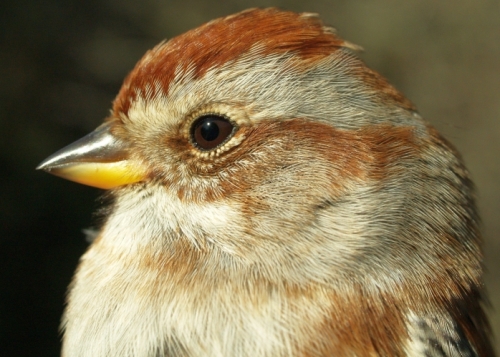
It was a great week at MBO for seeing American Tree Sparrows, as we banded far
more (54) in the past seven days than in any previous full fall season (34).
(Photo by Simon Duval )

|
MBO
gratefully acknowledges the financial support
provided for the 2009 Fall Migration Monitoring
Program by TD Friends of the Environment Foundation
|
|
|
|
THIS WEEK |
THIS FALL |
2009 TOTAL |
SITE TOTAL |
|
# birds (and species) banded |
351 (19) |
3390 (75) |
4394 (84) |
23315 (105) |
|
# birds (and species) repeat |
73 (9) |
606 (39) |
885 (50) |
4232 (66) |
|
# birds (and species) return |
2 (2) |
42 (18) |
160 (32) |
614 (37) |
|
# species observed |
52 |
143 |
166 |
199 |
|
# net hours |
377.4 |
5837.4 |
9195.9 |
39661.2 |
|
# birds banded / 100 net hours |
93.0 |
58.1 |
47.7 |
58.8 |
|
|
Note: table does not include nocturnal banding (owls) |
|
Banders-in-charge: Simon Duval, Marcel Gahbauer, Gay Gruner
Assistants: Christine Barrie, Jean Demers, Matthew Emrich, Nicki Fleming, Alyssa Gangai, Tiffany Gilchrist, Jeff Harrison, Marie-Anne Hudson, Daniel Jackson, Meg Langley, Melissa Lefebvre, Barbara MacDuff, Meghna Marjadi, Allison Moore, Chris Murphy, Ted Scodras, Clémence Soulard, Alex Stone, Rodger Titman, Carine Toumas
Notes: What an end to the season! We're used to numbers tapering off significantly in the final week of October, validating our decision to call an end to fall migration monitoring at that point. But this year week 13 was productive from beginning to end, with almost 50% more birds banded than in our previous best year, including 66 on our final day of the season. Out of curiosity, we will unofficially extend the season by one week to see just when the numbers do taper off this year ... the data will not count toward our fall totals for 2009, but may give us some insight into whether we need to consider adjusting our monitoring window in the future.
Not only did we band a surprisingly high number of birds this week, but it was also good for observations. For the second time this year, we added our only new site species of the season on its final day. For spring migration, it was a Carolina Wren; this time it was a Townsend's Solitaire that flew by and gave away its identity via its song on Friday's census, becoming the 199th species recorded at MBO. We also managed to add two species to our list of birds observed at MBO this year (Northern Pintail and Long-eared Owl), plus another five that we hadn't yet seen this fall (Green-winged Teal, Northern Shoveler, Rough-legged Hawk, Golden Eagle, and Northern Shrike). The Northern Shrike was also the first one banded this year, as was a White-breasted Nuthatch.
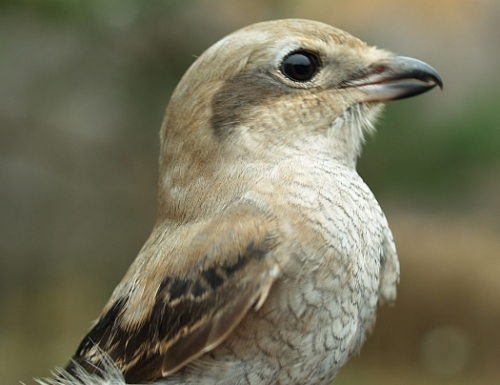
We were lucky to band two species on the final two days of the season that we hadn't handled yet this year. Every year except 2006 we've banded at least one Northern Shrike near the end of the fall season, but this year we had to wait until the very last day to catch the hatch-year bird shown above. Meanwhile, the after-hatch-year male White-breasted Nuthatch below is only the 5th of its kind ever banded at MBO, and the first since fall 2006!
(Photos by Simon Duval)
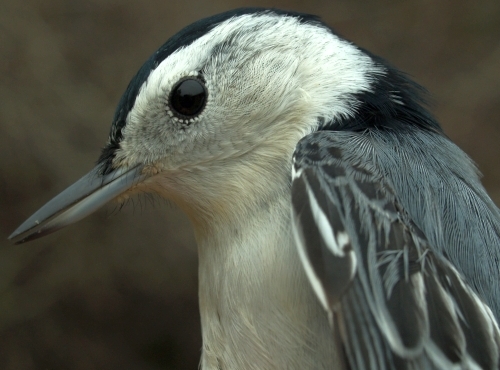
|
Since we have been reporting on our owl banding efforts, a quick update is in order. It was another rather modest week, with another 7 saw-whets banded, bringing our season total to 64. Since we have had some success in early November in past years, we will continue that program a bit longer to see whether we can band any late stragglers. But even if we don't catch any more, we've already had a phenomenal year, banding roughly four times as many as in previous seasons, and getting data on two foreign recoveries, mentioned in last week's report.
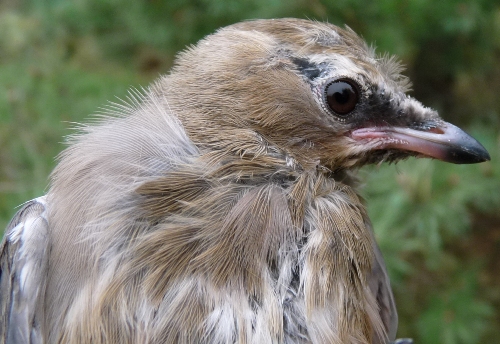
These two birds are at opposite ends of the age spectrum. The juvenile Cedar Waxwing above looks like it has been out of the nest for only a couple of weeks - hard to believe given that we banded it in the final week of October, but it seems a few birds nested unusually late this year. In contrast, the Black-capped Chickadee below is an old friend, banded during our 2004 fall pilot season, and frequently encountered ever since. Also of note this week was a Blue Jay we banded in 2005 and had not recaptured again until this week.
(Photos by Marcel Gahbauer)
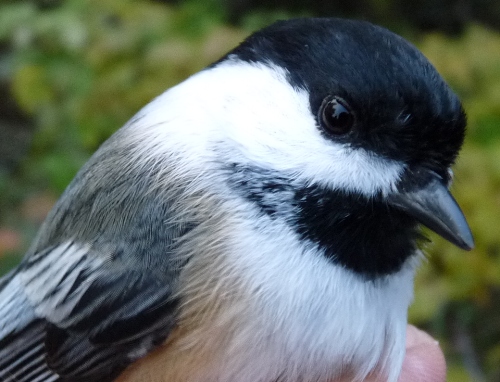
|
Slate-coloured Junco remained the most frequently banded species for a second week, and by a large margin this time over American Tree Sparrow, which have jumped up from near the bottom of last week's list. Conversely, American Robin has fallen far down the list, despite being #1 at this time for the past three years. Black-capped Chickadees continued to migrate in good numbers with this week's count bringing us to 75 over the past two weeks, and over 150 for the season, keeping true for a fifth year to our observation of a two-year cycle in the number of migrants of this species at MBO. Fox Sparrows also kept coming strong this week, and we continued to band new Song Sparrows this week, enough so that they managed to rank in the top 7 for every week this fall. Overall it was a great fall for sparrows, with record numbers banded for Fox, American Tree, White-throated, Song, and Junco - and with the latter three representing the top three species for the season on the whole. Again the two kinglets rounded out the end of this week's top ten, this time with a few late Swamp Sparrows keeping them company.
This week’s top 10 [last week's rank in brackets]
# individuals banded |
mean # individuals observed daily |
1. Slate-coloured Junco (175) [1] |
1. Red-winged Blackbird (465.0) [1] |
2. American Tree Sparrow (54) [9] |
2. American Robin (173.9) [2] |
3. Black-capped Chickadee (44) [4] |
3. American Crow (142.9) [4] |
4. White-throated Sparrow (22) [3] |
4. Canada Goose (91.3) [3] |
5. Fox Sparrow (17) [7] |
5. Slate-coloured Junco (71.1) [5] |
6. Song Sparrow (9) [6] |
6. Mallard (33.4) [-] |
6. American Robin (9) [2] |
7. Black-capped Chickadee (28.9) [6] |
8. Ruby-crowned Kinglet (4) [8] |
8. White-throated Sparrow (21.9) [8] |
9. Golden-crowned Kinglet (3) [10] |
9. American Tree Sparrow (16.4) [-] |
9. Swamp Sparrow (3) [-] |
10. European Starling (14.7) [7] |
|
Again this week Red-winged Blackbirds came out with the highest daily average of individuals observed, though in this case it was largely on the strength of over 2000 individuals flying over the site on Tuesday morning (including one massive flock estimated at 1200 birds). American Robins were more consistent, but most were flying high, accounting for the very small percentage that ended up in the nets. The rest of the top five also remained fairly consistent, except for American Crow and Canada Goose swapping positions. Black-capped Chickadee and White-throated Sparrow remained numerous enough on migration to stay in the bottom half of the list, while American Tree Sparrow increased enough to be added to the list, and nearly daily flights of Mallards gave us our first non-goose waterfowl entry in a long while.
It has been a long season, and we are ready to shift to a much lower gear for winter. We will as always be putting together a seasonal report summarizing all of the fall 2009 results, and will post it to the website when it is ready, hopefully before the end of December. But for now, we want to express our heartfelt thanks to everyone who contributed to making our fifth full fall season at MBO a resounding success - we couldn't have done it without the support of all the volunteers listed at the top of each weekly report, as well as those helping out behind the scenes with site management, fundraising, and logistics. Thank you all, and we look forward to your continued involvement in 2010 and beyond!
|
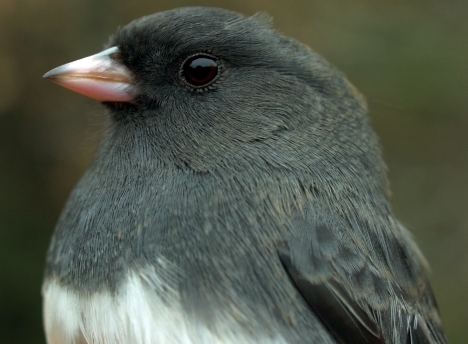
Juncos dominated the nets during our final week of fall, accounting for half of all birds banded. In the process, we witnessed quite a variety of plumages - not only good examples of all age/sex classes, but also a couple of oddities. The bird above was our final bird banded of the 2009 fall season, a handsome after-hatch-year male.
(Photo by Simon Duval)

At the opposite extreme from the male in the first photo, this hatch-year female is very pale, with a considerable brown wash to her plumage both front and back.
(Photo by Marcel Gahbauer)
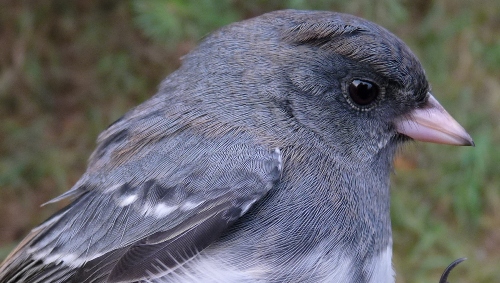
Two of the male juncos this week had distinct white tips on their greater and median coverts. Although there is a western race known as White-winged Junco, it wouldn't be expected this far east, and in any case is considerably larger than the eastern Slate-coloured Junco. Perhaps though there are some western genes in the ancestry of these birds?
(Photo by Marcel Gahbauer)
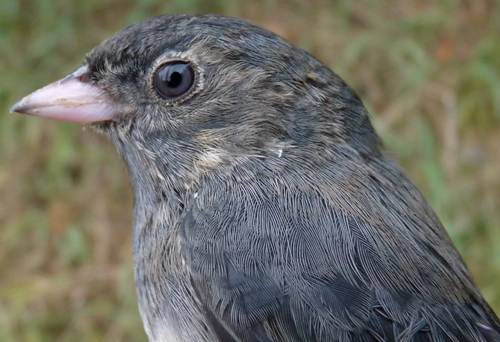
Sometimes we see individuals that just don't match any of our usual expectations for a species. This particular junco had a scruffy look, with pale patches around the head, including a bit of an eye-ring, highlighting the very gray iris.
(Photo by Marcel Gahbauer)
|










